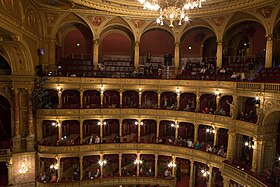Otto Klemperer
[2][n 2] The family name had originally been Klopper, but was changed to Klemperer in 1787 in response to a decree by the Austrian emperor Joseph II aimed at assimilating Jews into Christian society.
[4] Nathan Klemperer was originally from Josefov, the ghetto in the Bohemian city of Prague; Ida was from a more prosperous Jewish family in Hamburg, of Sephardic descent.
In the interim he made his public debut as a conductor in May 1906, taking over from Fried after the first night of the fifty-performance run of Max Reinhardt's production of Orpheus in the Underworld at the New Theatre, Berlin.
[15] From Prague, Klemperer moved to be assistant conductor at the Hamburg State Opera (1910–1912), where the sopranos Lotte Lehmann and Elisabeth Schumann made their joint débuts under his direction.
[25] In 1923, Klemperer turned down an invitation from the Berlin State Opera to succeed Leo Blech as musical director; he declined the post, because he did not believe he would be given enough artistic authority over productions.
Klemperer was offered a ten-year contract and accepted it on condition that he would be allowed to conduct orchestral concerts in the theatre, and that he could employ his chosen design and stage experts.
[30] Klemperer's biographer Peter Heyworth describes the conductor's tenure at the Kroll as "of crucial significance in his career and the development of opera in the first half of the 20th century".
[9] The production divided critical opinion, which ranged from "A new outrage to a German masterpiece ... grotesque" to "an unusual and magnificent performance ... a fresh wind has blown tinsel and cobwebs away".
The British music critics gave the symphony a lukewarm reception, but Klemperer was widely praised for "the power of a dominating personality", "masterful control" and as "a great orchestral commander".
"[36] Klemperer's contract obliged him to transfer to the main State Opera, where, with such conductors as Bruno Walter, Wilhelm Furtwängler and Leo Blech already established, there was little important work for him.
[40] The orchestra's finances were perilous; Clark had lost a substantial portion of his fortune in the Great Depression and could no longer afford subventions on the scale of earlier years.
[42][43] He programmed music from Gurrelieder by his fellow exile and Los Angeles neighbour Arnold Schoenberg,[44] although the composer complained that Klemperer did not perform his works more often.
The New York concert-going public was deeply conservative[46] but despite Judson's warning that programming Mahler would be highly damaging at the box-office, Klemperer insisted on giving the Second Symphony.
[50][n 5] Having returned to Los Angeles, Klemperer conducted the orchestra's concerts there and in out-of-town venues such as San Diego, Santa Barbara, Fresno and Claremont.
He and the orchestra worked with leading soloists, including Artur Schnabel, Emanuel Feuermann, Joseph Szigeti, Bronisław Huberman and Lotte Lehmann.
[52] The governing board of the Pittsburgh Symphony approached Klemperer in early 1938, seeking his help in reconstituting the orchestra – an ad hoc group since 1927 – as a permanent ensemble.
[77] In The Observer Heyworth wrote that with "what promises to be our best choir [and] our best orchestra and a great conductor", Legge had given London "a Beethoven cycle that any city in the world, be it Vienna or New York, would envy".
He had to a considerable extent moved away from the experimental stagings of the Kroll years; the 1961 Fidelio was described as "traditional, unfussy, grandly conceived, and profoundly revealing",[16] and of "deep serenity" musically.
[93] The following January, after flying from Zürich to London to conduct Bruckner's Seventh Symphony, Klemperer announced the day before the concert that he could no longer cope with the strain of public performances.
[100][n 12] Then, in between recordings of mostly German classics – including works by Brahms, Bruckner, Mendelssohn, Schubert, Richard Strauss and Wagner – he ventured into the light French repertoire with the overtures to Fra Diavolo and La belle Hélène (1929).
[102] From the Los Angeles years there is only one purpose-made studio recording but several transcriptions of live radio broadcasts, ranging from symphonies by Beethoven, Bruckner and Dvořák to excerpts from operas by Gounod, Massenet, Puccini and Verdi.
[104] For the Vox label Klemperer recorded several sets in Vienna in 1951, including Beethoven's Missa solemnis praised by Legge as "grave and powerful".
[105] In the same year his broadcast performances in the Concertgebouw of Mahler's Kindertotenlieder and Second Symphony, with the soloists Jo Vincent and Kathleen Ferrier, were recorded and have been issued on disc by Decca.
[109] From the choral repertoire he and the Philharmonia Chorus and Orchestra recorded Bach's St Matthew Passion, Handel's Messiah and Brahms's German Requiem.
Solo singers in these recordings included Dietrich Fischer-Dieskau, Gottlob Frick, Christa Ludwig, Peter Pears, Elisabeth Schwarzkopf and Jon Vickers.
[110] The Bach set divided critical opinion: Robertson called it "a spiritual experience ... a glorious achievement";[111] the Stereo Record Guide, though conceding "the majesty of Klemperer's conception", found it "disappointing ... with plodding tempi".
[16] In the view of Grove's Dictionary, following Toscanini's retirement in April 1954 and Furtwängler's death seven months later, Klemperer was "generally accepted as the most authoritative interpreter of the central Austro-German repertory".
"[120] Mann complained that the conductor's direction of The Marriage of Figaro was "didactic, humourless, tortoise-like",[121] though his colleague Stanley Sadie found "Klemperer's leisured, cool, almost dispassionate view of the opera is not without its attractiveness. ...
The EMI producer Suvi Raj Grubb wrote: Cardus expressed regret that Klemperer had too rarely been allowed to programme Bruckner, "whose symphonies he encompassed with a grip and a vision which saw the end of a large musical shape in the beginning".
"[125] Of his contemporaneous recording of the Fifth Symphony, the same writers called it "a really individual reading", preferable to those of Toscanini, Walter or Erich Kleiber: "Klemperer treats the work as if he had just discovered its greatness, illuminating every page with a ceaseless care for detail.





